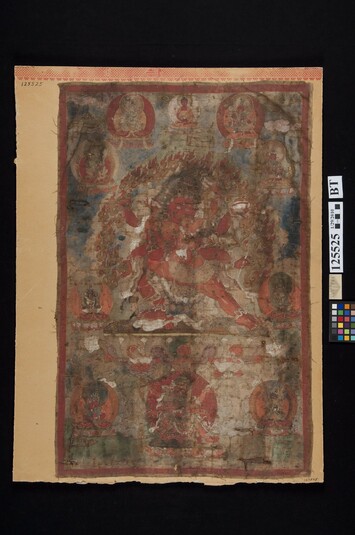
Item: Heruka (Nyingma)
| Origin Location | Tibet |
|---|---|
| Date Range | 1800 - 1899 |
| Lineages | Nyingma and Buddhist |
| Material | Ground Mineral Pigment on Cotton |
| Collection | Field Museum of Natural History |
Classification: Deity
Padma Vajra Heruka (Tibetan: drag tung. English: Blood-drinker): from the Lama Gongdu Cycle of Revealed Treasure (Tibetan: ter ma) teachings of the Nyingma tradition.
'...Padma Vajra, bright red, three faces, red, blue, [and] white. In the right [hands] a vajra, sword [and] skullcup. In the left a bell, vase [and] katvanga. The Red Lady holds a drum and skullcup. In a posture having the nine expressions of dance. Poised on a lotus, moon and sun.' (Jamyang Khyentse Chokyi Lodro. Daily Practice of Lama Gongdü).
Sanskrit: Heruka Tibetan: Drag tung
Tibetan: Drag tung
Wrathful in appearance, red in colour, with three faces and six hands he embraces the consort with the first pair. The outstretched right hands hold a vase and a sword. The two left hold a trident and a skullcup. The red two-armed consort holds a skullcup and a 'damara' drum. Standing on two prone forms, a sun disc and multi-coloured lotus seat.
Eight pairs of seated semi-wrathful figures surround the central figure. At the top center is Amitabha Buddha. and at the bottom is a wrathful deity.
Sanggye Lingpa (1340-1396) discovered the 'Middling Collection of Precepts, the Gathering of the Guru's Intention' (Tibetan: ka du bar wa la ma gong pa du pa) in the great cave of Puri Rinchen Barwa in the year 1364.
Jeff Watt 11-2000 [updated 11-2010]
Buddhist Deity: Lama Gongdu Terma Cycle (Main Page)
Buddhist Deity: Padma Vajra (Lama Gongdu)
Collection of the Field Museum of Natural History (Painting)



